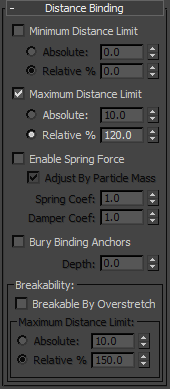When you set the mParticles Glue test binding type to Distance, mParticles Glue creates a "rope" binding from each particle to another particle, a deflector, or the ground. The endpoints of this virtual rope are called anchors.
The anchors are placed at the closest points between particle shapes, or between particle and deflector shapes. Once a binding rope is created, its length depends on restrictions that you specify. You can restrict the rope to have minimal length (like a stick to keep particles apart), or maximum length, or both minimum and maximum, or to add spring properties to the rope.
Interface

- Minimum Distance Limit
- When on, keeps binding anchors apart by at least the distance specified by the Absolute or Relative setting:
- Absolute Keeps all anchors apart by the same distance, in world units.
-
Relative % Defines the minimum distance as relative to the binding length (distance between anchors) at the moment of binding. So particles that were farther apart when remain relatively farther compared to others. This value is typically less than 100%.
For a video showing the effects of the Minimum Distance Limit option, see Minimum Distance Limit.
- Maximum Distance Limit
- When on, imposes a maximum separation limit between binding anchors, as specified by the Absolute or Relative setting.
Changing this setting doesn't affect interparticle distances at binding time, but if you increase the limit, the particles can move farther apart when acted on by outside forces while remaining bound together.
- Absolute Keeps all anchors from exceeding separation by the same distance, in world units.
-
Relative % Defines the maximum separation distance as relative to the binding length (distance between anchors) at the moment of binding. This value is typically greater than 100%.
For a video showing the effects of the Maximum Distance Limit option, see Maximum Distance Limit.
- Enable Spring Force
- When on, the meanings of Minimum Distance Limit and Maximum Distance Limit change. If the distance between binding anchors falls between the specified minimum and maximum values, no additional force is applied to the binding particles.
If the distance becomes less than the minimum (when Minimum Distance Limit is on) or greater than the maximum (when Maximum Distance Limit is on), then mParticles Glue attempts to restore the separation to the specified limits by exerting force to move particles apart or together. The magnitude of the force is determined by the Spring Coef setting and the relative deviation of the current binding length from minimum or maximum. That is, the greater the deviation from the specified minimum or maximum distance, the greater the force applied. The dynamics of the force are also defined by Damper Coef setting.
- Adjust By Particle Mass
- When on, the force is also multiplied by particle mass to have consistent acceleration values regardless of the particle mass.
- Spring Coef(ficient) Acts as a multiplier to the calculated force required to restore the specified binding distance range.
-
Damper Coef(ficient) Acts as a damping force, slowing down particle motion when the simulation attempts to restore the specified binding range. If, when using Spring Force, the particles seem to be snapping around too quickly, try increasing this value.
For videos showing the effects of the Enable Spring Force and Adjust By Particle Mass options, see Enable Spring Force and Adjust By Particle Mass.
- Bury Binding Anchors
- When on, the binding anchors are placed not on the surface of particle collision shapes, but instead are buried below the surface at the distance defined by the Depth setting (see following).
Use this option when particle shapes are very close to each other (such as touching spheres), with the result that normal binding lengths would be close to zero. By burying anchors under the collision surface, the binding distance is "artificially" enlarged, and the relative motion of bound particles is freer.
-
Depth The distance of the binding anchors below the surface of the particle collision shape.
For a video showing the effects of the Bury Binding Anchors option, see Bury Binding Anchors.
-
Depth The distance of the binding anchors below the surface of the particle collision shape.
Breakability group
- Breakable By Overstretch
- When on, a Distance binding can be broken if the length of the binding (distance between anchors) exceeds the specified value. Note that in certain circumstances a simulation cannot keep bindings at the Maximum Distance Limits; Distance bindings can overstretch.
Breakable By Overstretch is kind of a safeguard to release the bindings if the conditions do not allow the bindings to keep their Maximum Distance parameters.
- Maximum Distance Limit
- The distance at which a binding can be broken, in absolute or relative terms. This value is typically greater than the corresponding Maximum Distance Limit value.
- Absolute The absolute distance at which a binding can be broken, in world units.
- Relative % The maximum separation distance (beyond which the bond can break) as relative to the binding length (distance between anchors) at the moment of binding. This value is typically greater than 100%.
For a video showing the effects of the Breakable By Overstretch option, see Breakable By Overstretch.